DOWNLOAD
12 min read • Strategy
Blockchain in transport – Awaiting the breakthrough
Analyzing the impact of blockchain technology and identifying use cases within the transport industry
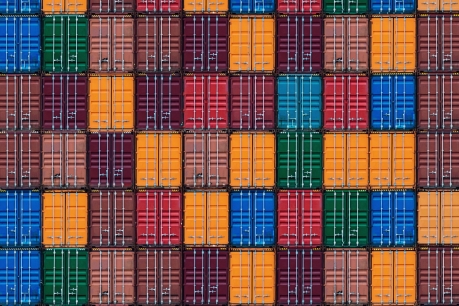
Blockchain seems the perfect solution for the complex, decentralized supply chains of the transport sector, but results to date have been disappointing. In this article, we analyze the latest global research with industry executives and use the findings to determine what needs to happen for the technology to reach its potential.
Since it came to prominence within financial services applications such as cryptocurrencies and digital asset exchanges, the race to find breakthrough applications for blockchain technology in other industries has been intense. However, despite major investments in knowledge, proofs of concept and pilots, the results and value generated from these efforts remain modest.

This has led to a change in attitude. Rather than asking when and where predicted disruptions will happen, many are now questioning “if” they will happen at all. As clear use cases have yet to emerge, it remains unclear whether the technology really is the silver bullet that companies have hoped for. This is particularly true in the transport industry, which was identified early on as a promising area for blockchain applications due to its large number of independent but linked players, decentralized nature, and need to deal with issues such as verifying authenticity, improving traceability, and transparency, all while reducing transaction costs.
Through a global survey and review of use cases, as well as interviews and research, backed up with insight from ADL’s past and current blockchain projects, this article investigates blockchain adoption in the transport industry. It describes common challenges and provides practical recommendations for the future.
About the survey
In October 2019, Arthur D. Little and BiTA (Blockchain in Transport Alliance) conducted an online survey of executives from more than 100 companies within the transport industry about current perceptions and adoption of blockchain technology. The survey aimed to evaluate the technology’s potential, assess the current degree of adoption, and explore the factors that could be driving or preventing further acceptance.
Blockchain today has failed to deliver benefits in the transport industry – Will this continue in the future?
After the introduction of Bitcoin in 2008, innovators and companies became interested in its underlying technology of distributed ledgers, specifically in blockchain. In a nutshell, a blockchain is a type of distributed, immutable ledger that allows for decentralized organization of data, with each computer node in a network holding an entire copy of the data set. This creates a self-governed, decentralized network that provides transparency, trust and traceability for all players in the network – a combination of characteristics unique to blockchain. With countless application possibilities mooted, significant hype around the technology followed. For example, Gartner1 predicted that blockchain would create more than $176 billion worth of business value by 2025 and over $3,000 billion by 2030. The transport industry was seen as one of the most promising areas in which to tap into this value.
Despite its seemingly close fit with the needs of the transport sector, blockchain success seems to be absent. The path to successful implementation remains unclear and project results do not match the initial enthusiasm of their promoters. By 2023, it is expected that 90 percent of blockchain-based supply chain initiatives will suffer “blockchain fatigue”, due to lack of proven use cases2.
However, even though the initial hype might seem to be over, the results of our recent online survey indicate that the transport industry still views blockchain as potentially disruptive. Over 70 percent of respondents believed blockchain could increase process efficiency, and nearly 60 percent said it had the potential to disrupt business models. Can the industry’s optimism still be justified?
To find out, our analysis has looked at four questions, which we’ve answered in order within this article:
- Is the transport industry still a promising application field for blockchain?
- Which transport challenges are best overcome with blockchain?
- What has prevented adoption of blockchain technology so far?
- What foundations need to be put in place to deliver breakthroughs in the next three years?
1. The benefits of blockchain to the transport industry
What is it that makes the combination of blockchain and transport interesting? Millions of people and hundreds of millions of tons of products and materials are transported around the world every day. Every supply chain is made up of a series of independent but connected players linking the source of a product to its ultimate destination, through a vast network of value-add processes, hand-overs and transactions. There is no central authority governing the entire supply chain, but rather, general practice, contracts and trust.
The global logistics market reached a value of $4,730 billion in 2018 and has a projected CAGR of 4.9 percent, to reach $6,300 billion by 20243. Due to this considerable growth, the number of manufacturers, suppliers, and third-party intermediaries involved is increasing rapidly, making today’s global supply chains increasingly complicated to manage. At the same time, increasing digitalization and data utilization lead to security and transparency concerns across the industry. To solve these issues and overcome mistrust among the industry’s countless players, companies are turning to technology such as blockchain to achieve competitive advantage and, ultimately, unlock growth possibilities.
2. The specific transport challenges that blockchain can overcome
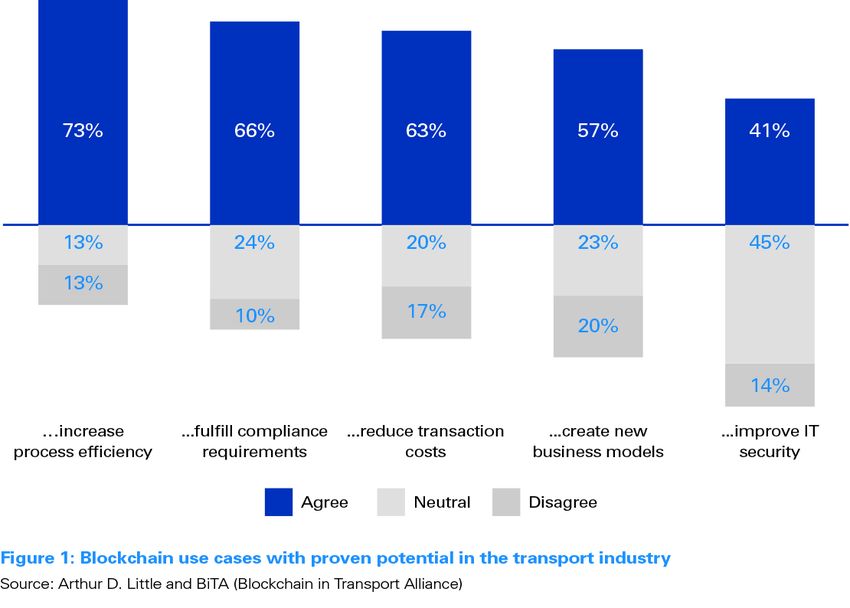
Our survey confirmed that users did see the potential of blockchain to tackle transport issues across the supply chain, as highlighted in Figure 1. In particular, users could see that it facilitated greater transparency and efficiency, resolving key challenges around inefficiency and information asymmetry among supply-chain players (Figure 2):
- Transparency and trust: Blockchain is well suited to providing end-to-end supply-chain transparency by creating a “single source of truth” to ensure traceability and security. In essence, it overcomes situations in which trust is lacking between parties that need to share information (such as financial data and intellectual property) without knowing one another. Through cryptography, blockchains enable all parties involved to add data, which is immutable and continuously updated in real time, providing complete transparency. Information about the origin, handling, and authenticity of goods and assets enables parties to improve quality assurance – thereby fighting counterfeits and building trust with consumers. One specific field is regulation and compliance. From pharmaceutical products to food and parcels, almost all goods change hands before final consumption – with organizations aiming to ensure that they are distributed compliantly. In our research, two out of three organizations that had already implemented blockchain solutions were using it to meet compliance requirements.
- Process efficiency: Our survey shows that 73 percent of executives feel blockchain has the potential to increase process efficiency within the transport industry through automatization and speed. In basic terms, smart contracts enable automated task execution and make manual checks for inaccuracies and fraud (often carried out by intermediaries) obsolete. Due to the speed and accuracy of self-executing contracts, organizations may save a significant amount of time and money, such as by removing the need to process manual paperwork or reconcile human errors before payments are released. A further blockchainspecific advantage is that every party in the value chain can access the same data around a product without needing to align on a common system.
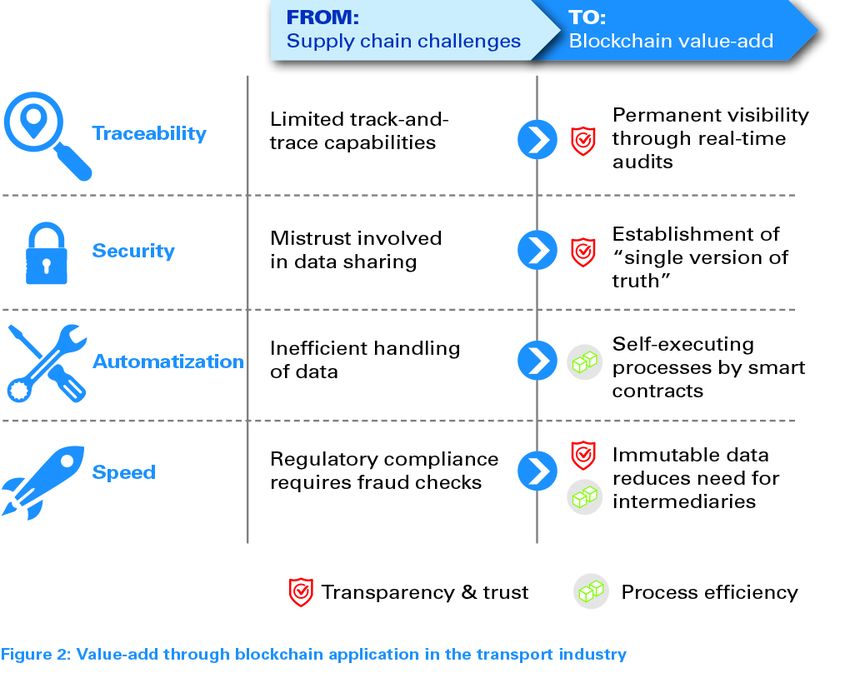
There are already some pioneering use cases for these types of applications in the transport industry. For example, ADL worked with a large mobility provider to create immutable visibility of goods movement for all logistics partners involved in the supply chain. Once changes of ownership are recorded through barcode scanning at the different trans-shipment points, data is securely stored in the blockchain and payments are automatically triggered. These self-executing contracts reduce processing of manual paperwork and help to prevent time delays, as well as additional work resulting from inefficient handling of data.
Another interesting example of a process enhancement via blockchain is Switzerland-based container specialist SkyCell. It developed a tailor-made transport solution for biopharmaceuticals – offering certainty where trust reaches its limits. Biopharmaceuticals are medical drugs based on proteins, and therefore exceptionally temperature sensitive. To ensure quality, no temperature deviations are acceptable when shipped. SkyCell offers insulated containers equipped with temperature sensors that record the inside temperature during delivery. When such a container’s barcode is scanned at a trans-shipment point, besides standard shipping information, temperature data is securely stored in the blockchain. This provides clients with reliable evidence about the cold chain, and they can therefore depend on the biopharmaceuticals’ effectiveness.
A third example is Maersk’s and IBM’s TradeLens platform, which applies blockchain technology to global supply chains via its trade document module, ClearWay, enabling secure, cross-business information exchange. This helps to prevent delays that result from inaccurate documentation or slow information exchange. In addition, our experience has demonstrated that warranty-handling (such as automating insurance payouts) and demand-planning processes between manufacturers and suppliers can be significantly streamlined by drawing on secure information exchange and selfexecuting contracts.
3. Obstacles to blockchain adoption and success
Apart from these and other pioneering use cases, blockchain implementations within the transport industry are still few and far between, despite the advantages. Our survey shows only a minority of organizations had launched blockchain projects to date. Two-thirds were still at the bottom two levels of maturity. Nearly one-quarter (24 percent) had not started projects, while an additional 43 percent were still in the planning stage. Figure 3 summarizes the barriers to blockchain technology progress in the transport industry.
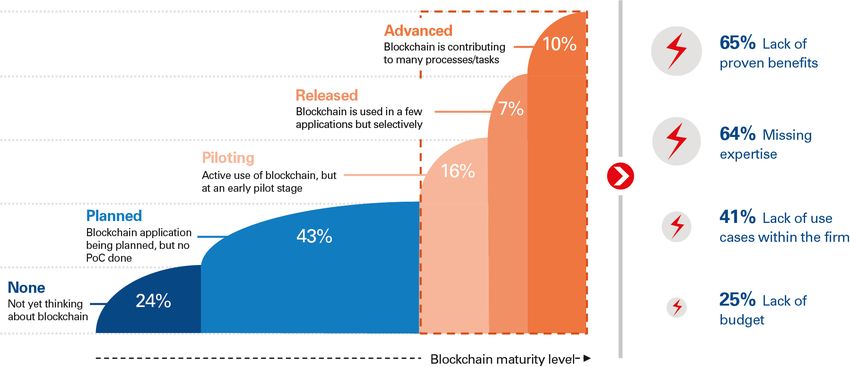
Executives identified two major challenges that are holding back blockchain adoption in the industry:
- Lack of proven benefits (cited by 65 percent of respondents): One of the biggest barriers is the lack of verifiable potential for blockchain applications. Most organizations are aware of use cases – but they do not know how to extract economic advantage from blockchain. This is demonstrated by the fact that just 41 percent of executives said scarcity of use cases was an issue. One reason players in the industry miss blockchain’s proven potential is that they still need to coordinate the complex ecosystems it entails – more precisely, their immaturity and lack of required industry standards to implement solutions across the overarching supply chain.
- Missing expertise (64 percent): When it comes to implementing new technology, know-how is crucial. Nearly two-thirds of executives regarded missing expertise as one of the major factors preventing blockchain-related projects. As blockchain is still a nascent technology, specific knowledge, not only around coding, but also the complicated concepts of the underlying technology, is scarce. Despite the growth in demand for blockchain experts, and the availability of numerous online training programs and educational services, the availability of talent is still lagging.
However, we believe there is one additional challenge that holds back organizations – we have seen it multiple times in our casework experience:
- Lack of technological foundations: Real blockchain breakthroughs are based on new or improved business models. However, during our projects we see many organizations still lacking the necessary technology foundations, such as integrating tagging technologies for asset registration and being able to handle real-time data digitally. Essentially, blockchain implementations only add value if basic value-chain processes are digitalized end to end – and this is far from the case for many players.
Given these factors, does this mean industry executives believe blockchain is not going to deliver value to the transport sector? Far from it – the survey demonstrates that the significance of blockchain is expected to change drastically over time. Fifty-seven percent of respondents felt it would enable breakthroughs within the next three years. Bearing these challenges in mind, what is the best way for companies in the industry to move forward with blockchain?
4. Cornerstones for blockchain implementation in coming years
Our experience tells us that it is now time to move beyond the hype and get-rich-quick schemes towards a more rational, less euphoric approach. This recommendation holds especially true for existing players operating in transport, but is also applicable to organizations in many other industries. We recommend that executives follow four cornerstones, as illustrated in Figure 4.
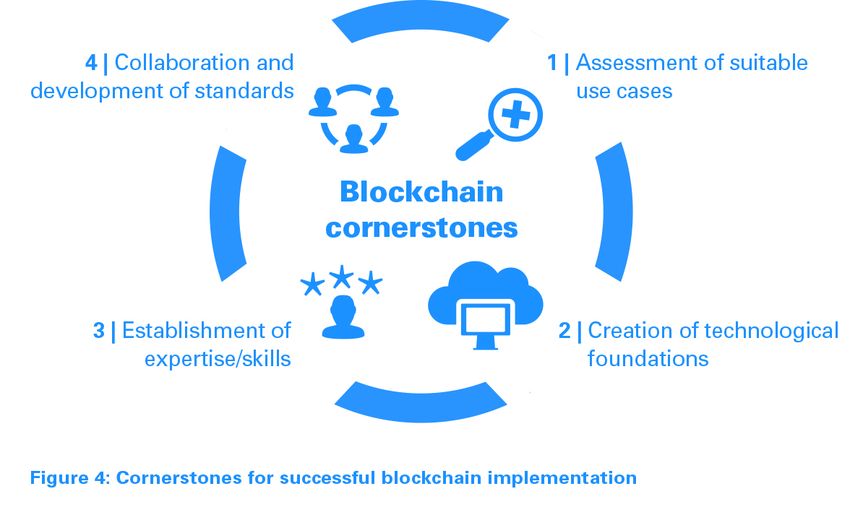
- Assessment of suitable use cases: We recommend that organizations in the transport industry first assess the potential impact of use cases instead of striving for first-mover advantages by rushing quickly into blockchain applications. Typically, only 10 percent of emerging use cases are likely to be implemented. Hence, investigation of the strategic fit with core competencies, addressed pain points, and feasibility are critical. In addition, development of practical proofs of concept within selected parts of the blockchain infrastructure is an effective method to avoid waves of repeated failure.
- Creation of technological foundations: Within our case work, we often experience organizations rushing into piloting projects without establishing the requirements for successful application. We advise firms to first establish the necessary foundations for blockchain technology – be they end-to-end process digitization or more transport-specific options such as implementation of “tagging technologies”, for example, barcodes and RFID, to provide real-time and accurate data capture. Blockchain will not help if the underlying data is inaccurate or incomplete.
- Establishment of expertise/skills: As stated before, blockchain expertise is not easy to find. Once promising use cases have been validated, organizations should strive to educate or hire tech-savvy and quick-to-learn individuals who can understand new applications in context – instead of only trying to recruit blockchain experts. In addition, organizations should seek collaboration with academic and specialist technical institutions in order to help shape the technology research and development agenda and gain access to key expertise. Finally, the organization itself needs to be suitably adapted to ensure the necessary blockchain expertise, whether internal or external, is connected and accessible to the key business functions.
- Collaboration and development of standards: The major advantage of blockchain is its network effect – simply put, the benefits increase with the size of the network and ecosystem. A manufacturing company is not adding value with the technology if its business partners are not connected. Organizations need to make efforts to explain to their partners how the system works – for example, how to upload data to the blockchain application using an onboarding system. Also, collaboration in a blockchain network is the right first step, but on its own, it is not sufficient. Ultimately, organizations will only reap significant benefits when suitable standards and a policy framework are in place, covering, for example, privacy standards, data sharing and storage, taxonomies, and access rights. Organizations need to collaborate and support the industry in developing these standards and policies.
Insight for the executive
With the hype around blockchain having subsided somewhat, we believe large-scale, near-term application is now more likely than ever before. This holds true for not only the transport industry, but also other sectors, provided that companies adopt the right approach, as set out in the cornerstones described above. Still, investments in blockchain (and related projects) remain costly and returns on investment are often uncertain. First movers are exposed to the risk of ultimately ending up at a disadvantage.
We recommend that companies undertake robust assessments of market, commercial and technical factors, as well as their own capabilities with regard to blockchain, before jumping into implementations that may fail to deliver. Several factors, including value-chain fragmentation, supply-chain power, existing skills and company-specific use cases, have to be considered to create a bespoke blockchain strategy.
Based on our survey findings and consulting experience, we highlight three viable generic approaches that companies can take:
- Monitor, but do not act yet: Pay attention and observe evolving use cases and blockchain activities of business partners.
- Take a defensive approach: Focus on suitable, prioritized use cases and establish your technological/organizational foundation.
- Move forward rapidly: Invest in scaling of use cases, create standards, and support/enable business partners in using blockchain.
When choosing tactics, companies should be aware that the blockchain train has already left the station. Catching up may turn out to be expensive or, even worse, impossible. If you have not yet acquired the necessary capabilities, and you lack a promising market or commercial perspective, keep out of the blockchain game for now. On the contrary, if you have the necessary capabilities at hand and possess a strong commercial perspective, then push widely to scale up use cases and returns. If you are somewhere in between, make sure you invest enough in the blockchain cornerstones so you can achieve a position of early follower if and when blockchain finally achieves its breakthrough.
To assist, we have developed a short self-assessment questionnaire, called the Blockchain Readiness Assessment, /en/blockchain-assessment which helps you select the best blockchain approach for your company.
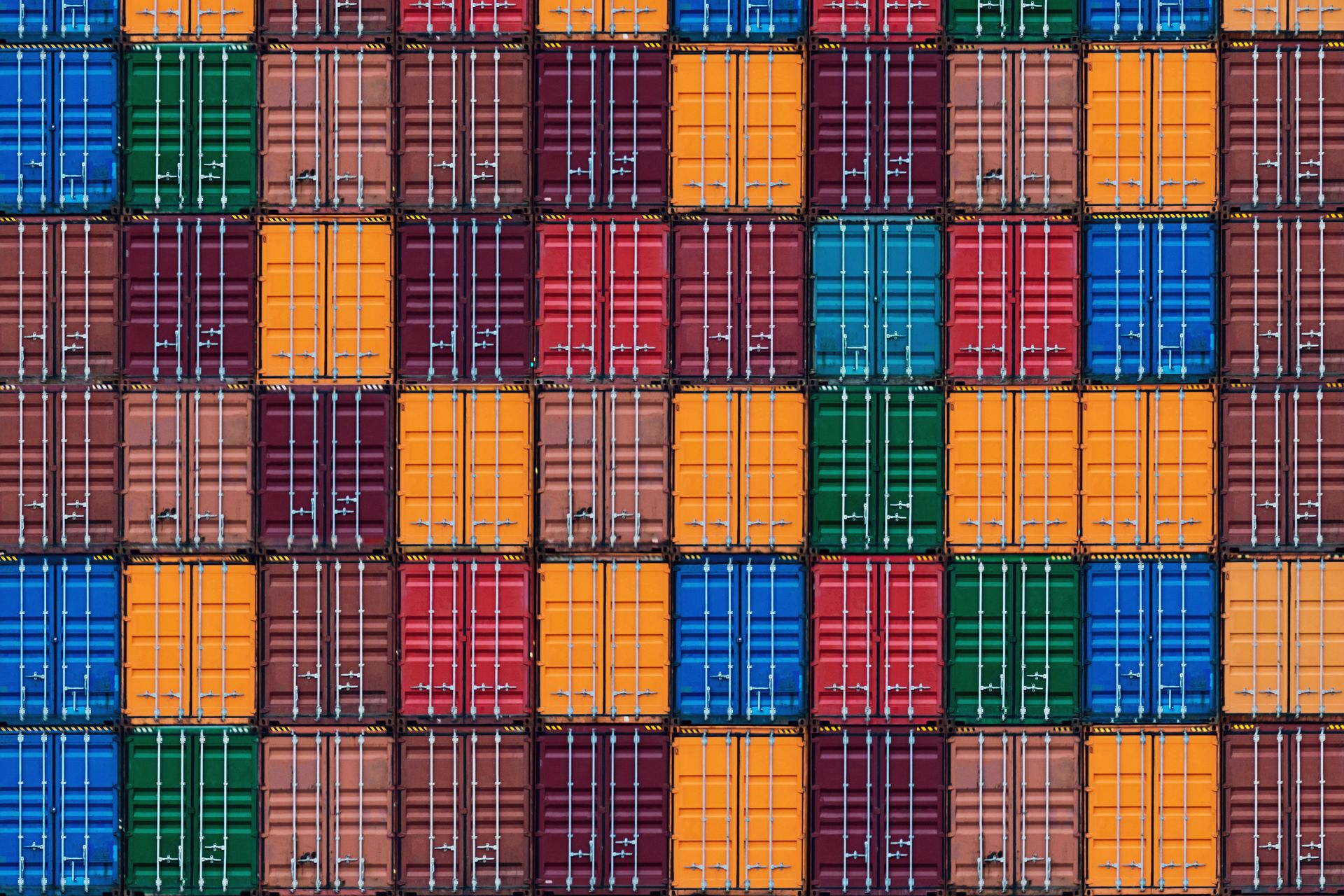
12 min read • Strategy
Blockchain in transport – Awaiting the breakthrough
Analyzing the impact of blockchain technology and identifying use cases within the transport industry


Blockchain seems the perfect solution for the complex, decentralized supply chains of the transport sector, but results to date have been disappointing. In this article, we analyze the latest global research with industry executives and use the findings to determine what needs to happen for the technology to reach its potential.
Since it came to prominence within financial services applications such as cryptocurrencies and digital asset exchanges, the race to find breakthrough applications for blockchain technology in other industries has been intense. However, despite major investments in knowledge, proofs of concept and pilots, the results and value generated from these efforts remain modest.

This has led to a change in attitude. Rather than asking when and where predicted disruptions will happen, many are now questioning “if” they will happen at all. As clear use cases have yet to emerge, it remains unclear whether the technology really is the silver bullet that companies have hoped for. This is particularly true in the transport industry, which was identified early on as a promising area for blockchain applications due to its large number of independent but linked players, decentralized nature, and need to deal with issues such as verifying authenticity, improving traceability, and transparency, all while reducing transaction costs.
Through a global survey and review of use cases, as well as interviews and research, backed up with insight from ADL’s past and current blockchain projects, this article investigates blockchain adoption in the transport industry. It describes common challenges and provides practical recommendations for the future.
About the survey
In October 2019, Arthur D. Little and BiTA (Blockchain in Transport Alliance) conducted an online survey of executives from more than 100 companies within the transport industry about current perceptions and adoption of blockchain technology. The survey aimed to evaluate the technology’s potential, assess the current degree of adoption, and explore the factors that could be driving or preventing further acceptance.
Blockchain today has failed to deliver benefits in the transport industry – Will this continue in the future?
After the introduction of Bitcoin in 2008, innovators and companies became interested in its underlying technology of distributed ledgers, specifically in blockchain. In a nutshell, a blockchain is a type of distributed, immutable ledger that allows for decentralized organization of data, with each computer node in a network holding an entire copy of the data set. This creates a self-governed, decentralized network that provides transparency, trust and traceability for all players in the network – a combination of characteristics unique to blockchain. With countless application possibilities mooted, significant hype around the technology followed. For example, Gartner1 predicted that blockchain would create more than $176 billion worth of business value by 2025 and over $3,000 billion by 2030. The transport industry was seen as one of the most promising areas in which to tap into this value.
Despite its seemingly close fit with the needs of the transport sector, blockchain success seems to be absent. The path to successful implementation remains unclear and project results do not match the initial enthusiasm of their promoters. By 2023, it is expected that 90 percent of blockchain-based supply chain initiatives will suffer “blockchain fatigue”, due to lack of proven use cases2.
However, even though the initial hype might seem to be over, the results of our recent online survey indicate that the transport industry still views blockchain as potentially disruptive. Over 70 percent of respondents believed blockchain could increase process efficiency, and nearly 60 percent said it had the potential to disrupt business models. Can the industry’s optimism still be justified?
To find out, our analysis has looked at four questions, which we’ve answered in order within this article:
- Is the transport industry still a promising application field for blockchain?
- Which transport challenges are best overcome with blockchain?
- What has prevented adoption of blockchain technology so far?
- What foundations need to be put in place to deliver breakthroughs in the next three years?
1. The benefits of blockchain to the transport industry
What is it that makes the combination of blockchain and transport interesting? Millions of people and hundreds of millions of tons of products and materials are transported around the world every day. Every supply chain is made up of a series of independent but connected players linking the source of a product to its ultimate destination, through a vast network of value-add processes, hand-overs and transactions. There is no central authority governing the entire supply chain, but rather, general practice, contracts and trust.
The global logistics market reached a value of $4,730 billion in 2018 and has a projected CAGR of 4.9 percent, to reach $6,300 billion by 20243. Due to this considerable growth, the number of manufacturers, suppliers, and third-party intermediaries involved is increasing rapidly, making today’s global supply chains increasingly complicated to manage. At the same time, increasing digitalization and data utilization lead to security and transparency concerns across the industry. To solve these issues and overcome mistrust among the industry’s countless players, companies are turning to technology such as blockchain to achieve competitive advantage and, ultimately, unlock growth possibilities.
2. The specific transport challenges that blockchain can overcome

Our survey confirmed that users did see the potential of blockchain to tackle transport issues across the supply chain, as highlighted in Figure 1. In particular, users could see that it facilitated greater transparency and efficiency, resolving key challenges around inefficiency and information asymmetry among supply-chain players (Figure 2):
- Transparency and trust: Blockchain is well suited to providing end-to-end supply-chain transparency by creating a “single source of truth” to ensure traceability and security. In essence, it overcomes situations in which trust is lacking between parties that need to share information (such as financial data and intellectual property) without knowing one another. Through cryptography, blockchains enable all parties involved to add data, which is immutable and continuously updated in real time, providing complete transparency. Information about the origin, handling, and authenticity of goods and assets enables parties to improve quality assurance – thereby fighting counterfeits and building trust with consumers. One specific field is regulation and compliance. From pharmaceutical products to food and parcels, almost all goods change hands before final consumption – with organizations aiming to ensure that they are distributed compliantly. In our research, two out of three organizations that had already implemented blockchain solutions were using it to meet compliance requirements.
- Process efficiency: Our survey shows that 73 percent of executives feel blockchain has the potential to increase process efficiency within the transport industry through automatization and speed. In basic terms, smart contracts enable automated task execution and make manual checks for inaccuracies and fraud (often carried out by intermediaries) obsolete. Due to the speed and accuracy of self-executing contracts, organizations may save a significant amount of time and money, such as by removing the need to process manual paperwork or reconcile human errors before payments are released. A further blockchainspecific advantage is that every party in the value chain can access the same data around a product without needing to align on a common system.

There are already some pioneering use cases for these types of applications in the transport industry. For example, ADL worked with a large mobility provider to create immutable visibility of goods movement for all logistics partners involved in the supply chain. Once changes of ownership are recorded through barcode scanning at the different trans-shipment points, data is securely stored in the blockchain and payments are automatically triggered. These self-executing contracts reduce processing of manual paperwork and help to prevent time delays, as well as additional work resulting from inefficient handling of data.
Another interesting example of a process enhancement via blockchain is Switzerland-based container specialist SkyCell. It developed a tailor-made transport solution for biopharmaceuticals – offering certainty where trust reaches its limits. Biopharmaceuticals are medical drugs based on proteins, and therefore exceptionally temperature sensitive. To ensure quality, no temperature deviations are acceptable when shipped. SkyCell offers insulated containers equipped with temperature sensors that record the inside temperature during delivery. When such a container’s barcode is scanned at a trans-shipment point, besides standard shipping information, temperature data is securely stored in the blockchain. This provides clients with reliable evidence about the cold chain, and they can therefore depend on the biopharmaceuticals’ effectiveness.
A third example is Maersk’s and IBM’s TradeLens platform, which applies blockchain technology to global supply chains via its trade document module, ClearWay, enabling secure, cross-business information exchange. This helps to prevent delays that result from inaccurate documentation or slow information exchange. In addition, our experience has demonstrated that warranty-handling (such as automating insurance payouts) and demand-planning processes between manufacturers and suppliers can be significantly streamlined by drawing on secure information exchange and selfexecuting contracts.
3. Obstacles to blockchain adoption and success
Apart from these and other pioneering use cases, blockchain implementations within the transport industry are still few and far between, despite the advantages. Our survey shows only a minority of organizations had launched blockchain projects to date. Two-thirds were still at the bottom two levels of maturity. Nearly one-quarter (24 percent) had not started projects, while an additional 43 percent were still in the planning stage. Figure 3 summarizes the barriers to blockchain technology progress in the transport industry.

Executives identified two major challenges that are holding back blockchain adoption in the industry:
- Lack of proven benefits (cited by 65 percent of respondents): One of the biggest barriers is the lack of verifiable potential for blockchain applications. Most organizations are aware of use cases – but they do not know how to extract economic advantage from blockchain. This is demonstrated by the fact that just 41 percent of executives said scarcity of use cases was an issue. One reason players in the industry miss blockchain’s proven potential is that they still need to coordinate the complex ecosystems it entails – more precisely, their immaturity and lack of required industry standards to implement solutions across the overarching supply chain.
- Missing expertise (64 percent): When it comes to implementing new technology, know-how is crucial. Nearly two-thirds of executives regarded missing expertise as one of the major factors preventing blockchain-related projects. As blockchain is still a nascent technology, specific knowledge, not only around coding, but also the complicated concepts of the underlying technology, is scarce. Despite the growth in demand for blockchain experts, and the availability of numerous online training programs and educational services, the availability of talent is still lagging.
However, we believe there is one additional challenge that holds back organizations – we have seen it multiple times in our casework experience:
- Lack of technological foundations: Real blockchain breakthroughs are based on new or improved business models. However, during our projects we see many organizations still lacking the necessary technology foundations, such as integrating tagging technologies for asset registration and being able to handle real-time data digitally. Essentially, blockchain implementations only add value if basic value-chain processes are digitalized end to end – and this is far from the case for many players.
Given these factors, does this mean industry executives believe blockchain is not going to deliver value to the transport sector? Far from it – the survey demonstrates that the significance of blockchain is expected to change drastically over time. Fifty-seven percent of respondents felt it would enable breakthroughs within the next three years. Bearing these challenges in mind, what is the best way for companies in the industry to move forward with blockchain?
4. Cornerstones for blockchain implementation in coming years
Our experience tells us that it is now time to move beyond the hype and get-rich-quick schemes towards a more rational, less euphoric approach. This recommendation holds especially true for existing players operating in transport, but is also applicable to organizations in many other industries. We recommend that executives follow four cornerstones, as illustrated in Figure 4.

- Assessment of suitable use cases: We recommend that organizations in the transport industry first assess the potential impact of use cases instead of striving for first-mover advantages by rushing quickly into blockchain applications. Typically, only 10 percent of emerging use cases are likely to be implemented. Hence, investigation of the strategic fit with core competencies, addressed pain points, and feasibility are critical. In addition, development of practical proofs of concept within selected parts of the blockchain infrastructure is an effective method to avoid waves of repeated failure.
- Creation of technological foundations: Within our case work, we often experience organizations rushing into piloting projects without establishing the requirements for successful application. We advise firms to first establish the necessary foundations for blockchain technology – be they end-to-end process digitization or more transport-specific options such as implementation of “tagging technologies”, for example, barcodes and RFID, to provide real-time and accurate data capture. Blockchain will not help if the underlying data is inaccurate or incomplete.
- Establishment of expertise/skills: As stated before, blockchain expertise is not easy to find. Once promising use cases have been validated, organizations should strive to educate or hire tech-savvy and quick-to-learn individuals who can understand new applications in context – instead of only trying to recruit blockchain experts. In addition, organizations should seek collaboration with academic and specialist technical institutions in order to help shape the technology research and development agenda and gain access to key expertise. Finally, the organization itself needs to be suitably adapted to ensure the necessary blockchain expertise, whether internal or external, is connected and accessible to the key business functions.
- Collaboration and development of standards: The major advantage of blockchain is its network effect – simply put, the benefits increase with the size of the network and ecosystem. A manufacturing company is not adding value with the technology if its business partners are not connected. Organizations need to make efforts to explain to their partners how the system works – for example, how to upload data to the blockchain application using an onboarding system. Also, collaboration in a blockchain network is the right first step, but on its own, it is not sufficient. Ultimately, organizations will only reap significant benefits when suitable standards and a policy framework are in place, covering, for example, privacy standards, data sharing and storage, taxonomies, and access rights. Organizations need to collaborate and support the industry in developing these standards and policies.
Insight for the executive
With the hype around blockchain having subsided somewhat, we believe large-scale, near-term application is now more likely than ever before. This holds true for not only the transport industry, but also other sectors, provided that companies adopt the right approach, as set out in the cornerstones described above. Still, investments in blockchain (and related projects) remain costly and returns on investment are often uncertain. First movers are exposed to the risk of ultimately ending up at a disadvantage.
We recommend that companies undertake robust assessments of market, commercial and technical factors, as well as their own capabilities with regard to blockchain, before jumping into implementations that may fail to deliver. Several factors, including value-chain fragmentation, supply-chain power, existing skills and company-specific use cases, have to be considered to create a bespoke blockchain strategy.
Based on our survey findings and consulting experience, we highlight three viable generic approaches that companies can take:
- Monitor, but do not act yet: Pay attention and observe evolving use cases and blockchain activities of business partners.
- Take a defensive approach: Focus on suitable, prioritized use cases and establish your technological/organizational foundation.
- Move forward rapidly: Invest in scaling of use cases, create standards, and support/enable business partners in using blockchain.
When choosing tactics, companies should be aware that the blockchain train has already left the station. Catching up may turn out to be expensive or, even worse, impossible. If you have not yet acquired the necessary capabilities, and you lack a promising market or commercial perspective, keep out of the blockchain game for now. On the contrary, if you have the necessary capabilities at hand and possess a strong commercial perspective, then push widely to scale up use cases and returns. If you are somewhere in between, make sure you invest enough in the blockchain cornerstones so you can achieve a position of early follower if and when blockchain finally achieves its breakthrough.
To assist, we have developed a short self-assessment questionnaire, called the Blockchain Readiness Assessment, /en/blockchain-assessment which helps you select the best blockchain approach for your company.
